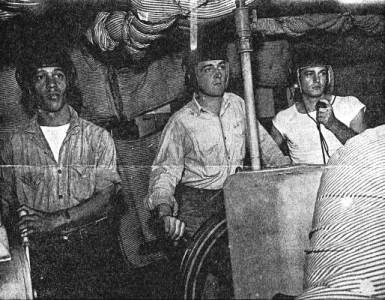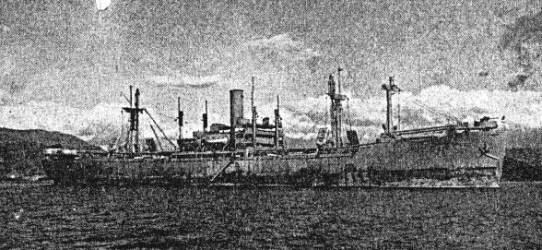| There are 3 articles about
the Guinea Pig Squadron on this page. The pictures were used by
all three articles, the combined descriptions are used with them.:
1: LOOKING FOR TROUBLE Volunteer-Manned Ships of ‘Guinea Pig Squadron’ Ply Jap Waters Seeking Deadly American Mines Menacing U. S. Vessels Deliberately seeking what other ships strive to avoid - contact with the deadly mines that lie beneath the waters of the bays and channels of Japan - were the ghost-like ships of the United States Navy’s “Guinea Pig Squadron.” Each with empty holds and manned only by a handful of sailors and officers whose occasional footsteps echoed hollowly down the long, dimly-lighted passageways, the guinea pig ships steamed the mine-strewn waters to make certain that the explosive-laden machines laid there were no longer a menace to American ships. |
THE CREW of the SS Joseph Holt stand in wheelhouse of their ship as they cruise Japanese bays and channels looking for “live” pressure mines hidden beneath the surface. The room is padded with mattresses and the men wear tank helmets to protect them from shock of possible explosions. (Associated Press wire photo.) Left to right, William H, Hill, S2/c., 26, of Brooklyn, N.Y.; Albin C. Scheppiner, QM2/c, 23, of Erie, PA., and Harvey L. Hunter, RM2/c, 21, of Vancouver, Wash. (US Navy photo) |
||||||
| During the war,
American planes, roaring low over these waters, sowed them with a new
pressure type mine which wreaked havoc with Japanese shipping. Unlike the
common moored, magnetic or acoustic mines, the new weapon is extremely
difficult to sweep. The mine is detonated by a change in the pressure of
the water surrounding it which ordinarily is caused only by the passage of
a large ship over the mine. Anticipating the invasion of Japan, these
mines were set to neutralize themselves. That is, they would become
non-explosive within a certain time after being laid.
But even after sweeping by small ships, first Japanese, then American, the only way to make certain that these mines were no longer dangerous was to run larger ships over them. And that was what the “Guinea Pig Squadron” accomplished, using battered ships that had been damaged by war and storms. These ships were manned by volunteer crews for whose safety all possible precautions were taken. Under the direction of Rear Admiral Arthur D. Struble, USN, Commander Minecraft, Pacific Fleet, the “guinea pigs” swept Nagoya and Bungo Suido waters, and then moved on to sweep the Hiro Wan and Kure areas of Japan’s Inland Sea. The hunting was poor and the luck all good. No mines exploded under them. The ships made their runs with skeleton crews of about 22 men each. The balance of the crews remained in port to take their turn on another sweep or to do necessary below-deck chores that wait until the ships had stopped “pigging” for the day. The ships had been fitted with remote controls so that the engines and boilers could be operated from the main deck and flying bridge rather than below in compartments which would become steam-filled death traps in the event of a mine explosion. To cushion the shock of possible explosion, the crew members stood on mattresses or raised wooden gratings at most of the stations, and wore tank helmets for head protection. The overheads above them likewise were well padded with mattresses. The three ships of the Guinea Pig Squadron “ were the USS Marathon (the flagship), the SS Pratt Victory and the SS Joseph Holt, a liberty ship. The Marathon is a former troop transport. The other two are freighters taken over by the Navy from the War Shipping Administration. The three ships usually steamed in echelon about 150 yards apart. A fleet tug equipped with complete salvage gear followed at the respectable distance of 1,500 yards. In the ships’ checking of the 40-mile channel from Hiro to Kure, the ships made 30 trips - four hours up and four hours back - over a period of six days. Like the rest of minesweeping, the work is monotonous - until something happens. Shattered half-sunk hulls of the Jap Navy and Merchant Marine, many which had conveniently exploded a mine, were passed daily. Each morning the ships were greeted by the punctual Kure mail train puffing along the beach in peacetime safety. Low clouds and icy mist made navigation difficult among the many small islands of the Inland Sea, even though marker buoys (dan buoys) - planted by the fleet of small minesweepers which had preceded the “guinea pigs” into the area - still remained to mark the 2,000-yard-wide channels which the ships were required to check. The skeleton crews of the ships munched on sandwiches during the day. But on returning to home base late in the evening they were greeted with a hot meal prepared by the mess cooks. The Marathon was torpedoed in Buckner Bay, Okinawa, early on the morning of 22 July, 1945 with the loss of 37 of her crew. The gaping hole torn in her port side forwarded by the torpedo was patched and she was put back into service. During her “guinea pig” operations the Marathon exploded a mine while sweeping the Kobe channel but the explosion did only superficial damage to the ship. The Pratt Victory likewise was torpedoed - on the starboard side in No. 2 hold about a month before the war ended. The hole was partially closed by a metal plate that extended down to the water line, but below that the hold was open to the sea. She could not steam at full speed because the sea pouring into the open hold would create a dangerous pressure on the bulkhead that separates it from the next hold. The third ship, the Joseph Holt, went aground in Buckner Bay during a typhoon. Her keel was believed to be slightly bent but it did not interfere with her steaming ability. Capt. Henry J. Armstrong, USN, Group Commander, declared regarding the crews of his three ships: “I’m proud of them. Their spirit has been excellent. They appear to have had no qualms - no thought of fear. The mere fact that we have not hit a mine is not our fault. It’s just a tribute to good sweeping.”
2: NAVY SEARCHES JAP WATERS FOR HIDDEN EXPLOSIVES ‘GUINEA PIGS’ SEEK LIVE MINES WASHINGTON, Dec. 30 (I.N.S.) - The Navy looked with pride today to its “guinea pig squadron,” a group of three ships that have been sweeping Japanese waters for unexploded pressure mines. The three ships of the squadron are the USS Marathon, the SS Pratt Victory and the SS Joseph Holt. The Marathon is a former troop transport, the other two are freighters taken over by the Navy from the War Shipping Administration. SWEPT MANY WATERS The ships, manned by volunteer crews, recently swept Nagoya and Bungo Suido waters and have just finished sweeping the Hiro Wan and Kure areas of Japan’s Inland Sea. So far the ships have been lucky. No mines have exploded under them. The ships make their runs with skeleton crews of about 22 men each. They have been fitted with remote controls so that the engines and boilers can be operated from the main deck and flying bridge without the necessity of anyone remaining below in compartments which could become steam-filled death traps in the event of a mine explosion. BLASTS CUSHIONED To cushion the shock of possible explosion, the crew members stand on mattresses or raised wooden gratings at most of the stations. They wear tank helmets for head protection and the ceilings above them are likewise padded with mattresses. The three ships usually steam in echelon about 150 yards apart. A fleet tug, equipped with complete salvage gear, follows at the respectable distance of 1500 yards. In their recent checking of the 40-mile channel from Hiro to Kure, the ships made 30 trips - four hours up and four hours back - over a period of six days. Capt. Henry J. Armstrong, of Santa Ana, Calif., is Group Commander of the ships. Regarding the crews of the three ships, he declared: “I’m proud of them. Their spirit has been excellent.” 3: ‘GUINEA PIG’ CREW HERE WITH STRANGEST TALE By Ray Coll, Jr. HAWAII’S TERRITORIAL NEWSPAPER Saturday Morning, January 26, 1946
The Liberty ship Joseph Holt recently returned from Japan where it was used as a “guinea-pig” to detonate pressure mines sowed by B-29’s. Some guys came out of the war bomb happy or shell happy after months of dodging kamikazes or curling up helplessly while enemy shells whizzed overhead or exploded close by, sometimes too close, but the strangest lot of all are the “guinea-pig happy” crews who took their ships into mine-filled waters of Japan after the war. One of these vessels, the Liberty ship Joseph Holt, was in port yesterday with a Navy crew of 79 including six officers and commanded by Lt. Cmdr. E. G. Rifenburgh, USNR, of New York, a former mate on the Grace Line passenger liner Santa Paula. Never Set Off a Mine |
|||||||


